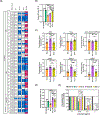SARS-CoV-2 BA.2.86 enters lung cells and evades neutralizing antibodies with high efficiency
- PMID: 38194966
- PMCID: PMC11317634
- DOI: 10.1016/j.cell.2023.12.025
SARS-CoV-2 BA.2.86 enters lung cells and evades neutralizing antibodies with high efficiency
Abstract
BA.2.86, a recently identified descendant of the severe acute respiratory syndrome coronavirus 2 (SARS-CoV-2) Omicron BA.2 sublineage, contains ∼35 mutations in the spike (S) protein and spreads in multiple countries. Here, we investigated whether the virus exhibits altered biological traits, focusing on S protein-driven viral entry. Employing pseudotyped particles, we show that BA.2.86, unlike other Omicron sublineages, enters Calu-3 lung cells with high efficiency and in a serine- but not cysteine-protease-dependent manner. Robust lung cell infection was confirmed with authentic BA.2.86, but the virus exhibited low specific infectivity. Further, BA.2.86 was highly resistant against all therapeutic antibodies tested, efficiently evading neutralization by antibodies induced by non-adapted vaccines. In contrast, BA.2.86 and the currently circulating EG.5.1 sublineage were appreciably neutralized by antibodies induced by the XBB.1.5-adapted vaccine. Collectively, BA.2.86 has regained a trait characteristic of early SARS-CoV-2 lineages, robust lung cell entry, and evades neutralizing antibodies. However, BA.2.86 exhibits low specific infectivity, which might limit transmissibility.
Keywords: BA.2.86; SARS-CoV-2; Spike protein; TMPRSS2; antibody evasion; fusion; infectivity; lung cell entry; mutations; pirola variant.
Copyright © 2023 Elsevier Inc. All rights reserved.
Conflict of interest statement
Declaration of interests A.K., I.N., S.P. and M.H. conducted contract research (testing of vaccinee sera for neutralizing activity against SARS-CoV-2) for Valneva unrelated to this work. G.M.N.B. served as advisor for Moderna, and S.P. served as advisor for BioNTech, unrelated to this work. A.D-J. served as advisor for Pfizer, unrelated to this work. The authors declare no competing interests.
Figures





References
-
- Hoffmann M, Arora P, Nehlmeier I, Kempf A, Cossmann A, Schulz SR, Morillas Ramos G, Manthey LA, Jack HM, Behrens GMN, and Pohlmann S (2023). Profound neutralization evasion and augmented host cell entry are hallmarks of the fast-spreading SARS-CoV-2 lineage XBB.1.5. Cell Mol Immunol 20, 419–422. 10.1038/s41423-023-00988-0. - DOI - PMC - PubMed
-
- Zhang L, Kempf A, Nehlmeier I, Cossmann A, Dopfer-Jablonka A, Stankov MV, Schulz S, Jack HM, Behrens GMN, Pöhlmann S, and Hoffmann H (In press). Neutralisation sensitivity of SARS-CoV-2 lineages EG.5.1 and XBB.2.3. Lancet Infect Dis. - PubMed
Publication types
MeSH terms
Substances
Supplementary concepts
Grants and funding
LinkOut - more resources
Full Text Sources
Medical
Miscellaneous

